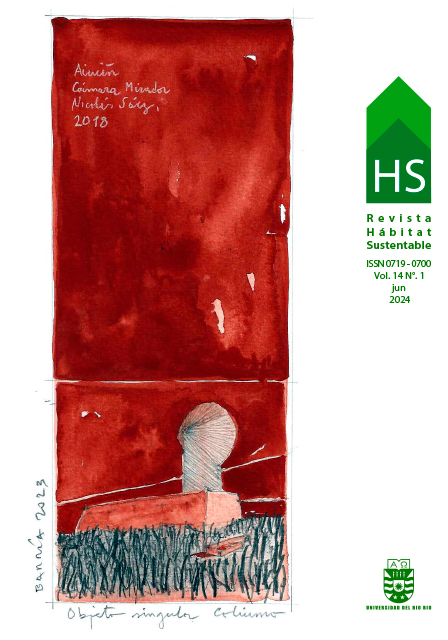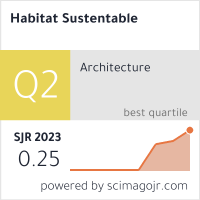Mejora de la eficiencia energética en fachadas de vidrio mediante estrategias de diseño biomimético
DOI:
https://doi.org/10.22320/07190700.2024.14.01.03Palabras clave:
biomímesis, diseño de fachadas, eficiencia energética, termorregulaciónResumen
La industria de la construcción, responsable de una gran proporción del consumo de energía, está buscando soluciones para reducir el consumo de energía. Este estudio propone fachadas biomiméticas para garantizar el confort térmico. En primer lugar, examinó los sistemas de fachadas biomiméticas en la literatura. Luego, analizó los métodos de termorregulación de la naturaleza, el nivel de biomimética y las estrategias desarrolladas por los seres vivos. Como resultado de los análisis, se amplió la información biológica relativa a los tres fenómenos seleccionados y se determinó cómo transferir el método de biomimética que podría estar en la envolvente del edificio. Se realizaron simulaciones de energía en la fachada de vidrio del baño Süleyman Pasha para evaluar la eficiencia energética de la envoltura. Se encontró que los métodos inspirados en la naturaleza contribuyeron significativamente al consumo de energía del edificio cuando se diseñaron los resultados de simulación de la fachada.
Descargas
Citas
ALY, Z., IBRAHIM, A., & ABDELMOHSEN, S. (2021). Augmenting passive actuation of hygromorphic skins in desert climates: learning from thorny devil lizard skins. In 9th International Conference of the Arab Society for Computer Aided Architectural Design, American University in Cairo, Egypt.
Asknature (n.d.). https://asknature.org/strategy/leaves-protect-from-freezing/
BADARNAH, L., FARCHI, Y. N., & KNAACK, U. (2010). Solutions from nature for building envelope thermoregulation. Design & Nature V: Comparing Design in Nature with Science and Engineering, 5, 251. https://doi.org/10.2495/DN100221
Cactus Kingdom (n.d.). https://cactuskingdom.ca/product/fenestraria-aurantiaca-baby-toes-seed/
ÇAĞLAR, S. (2020). Voronoi Diyagramları Dünyayı Anlamamızı Nasıl Sağlar? https://www.matematiksel.org/voronoi-diyagramlari-dunyayi-anlamamizi-nasil-saglar/
ENGIN, N. (2012). Enerji Etkin Tasarımda Pasif İklimlendirme: Doğal Havalandırma. Tesisat Mühendisliği, 129, 62-70. https://www.mmo.org.tr/sites/default/files/c8aa7c541085a2b_ek.pdf
FARAGALLA, A. M., & ASADI, S. (2022). Biomimetic design for adaptive building façades: a paradigm shift towards environmentally conscious architecture. Energies, 15(15), 5390. https://doi.org/10.3390/en15155390
FARCHI NACHMAN, Y. (2009). Learning from nature: Thermoregulation envelope, in Department of Building Technology. Delft University of Technology: Façade Design.
HELMS, M., VATTAM, S. S., & GOEL, A. K. (2009). Biologically inspired design: process and products. Design Studies, 30(5), 606–622. https://doi.org/10.1016/j.destud.2009.04.003
International Energy Agency. Energy Efficiency (2019). Buildings, The global exchange for energy efficiency policies, data and analysis.
KAHRAMANOĞLU, B., & ALP, N. Ç. (2021). Kinetik Sistemli Bina Cephelerinin Modelleme Yöntemlerinin İncelenmesi. AURUM Journal of Engineering Systems and Architecture, 5(1), 119-138. https://doi.org/10.53600/ajesa.861479
KALATHA, A. (2016). The water wall: A bio-inspired thermoregulative facade system. [Unpublished master thesis], Delft University of Technology, Netherlands.
KIM, K., & TORRES, A. (2021). Integrated Façades for Building Energy Conservation; IC-AIRES, Lecture Notes in Networks and Systems; Springer: Cham, Switzerland; 361.
KURU, A., OLDFIELD, P., BONSER, S., & FIORITO, F. (2019). Biomimetic adaptive building skins: Energy and environmental regulation in buildings. Energy and Buildings, 205, 109544. https://doi.org/10.1016/j.enbuild.2019.109544
LEE, E. S., & TAVIL, A. (2007). Energy and visual comfort performance of electrochromic windows with overhangs. Building and Environment, 42(6), 2439-2449. https://doi.org/10.1016/j.buildenv.2006.04.016
MUTLU AVINÇ, G., & ARSLAN SELÇUK, S. (2019). Mimari Tasarımda Biyomimetik Yaklaşımlar: Pavyonlar Üzerine Bir Araştırma. Online Journal Of Art & Design, 7(2), 92-107. http://www.adjournal.net/articles/72/728.pdf
ÖZTÜRK, BÜŞRA., (2023). Çağdaş eklerin tarihi yapının enerji performansına etkisinin incelenmesi [MSc thesis]. Konya Teknik University, Institute of Graduate Education, Konya.
PACHECO, R., ORDÓÑEZ, J., & MARTÍNEZ, G. (2012). Energy efficient design of building: A review. Renewable and Sustainable Energy Reviews, 16(6), 3559-3573. https://doi.org/10.1016/j.rser.2012.03.045
SHEIKH, W. T., & ASGHAR, Q. (2019). Adaptive biomimetic facades: Enhancing energy efficiency of highly glazed buildings. Frontiers of Architectural Research, 8(3), 319-331. https://doi.org/10.1016/j.foar.2019.06.001
SOMMESE, F., BADARNAH, L., & AUSIELLO, G. (2022). A critical review of biomimetic building envelopes: Towards a bio-adaptive model from nature to architecture. Renewable and Sustainable Energy Reviews, 169, 112850. https://doi.org/10.1016/j.rser.2022.112850
TABADKANI, A., ROETZEL, A., LI, H. X. & TSANGRASSOULIS, A. (2021). Design approaches and typologies of adaptive façades: A review. Automation in Construction. 121, 103450. https://doi.org/10.1016/j.autcon.2020.103450
PAAR, M. J., & PETUTSCHNIGG, A. (2016). Biomimetic inspired, natural ventilated facade–A conceptual study. Journal of Facade Design and Engineering, 4(3-4), 131-142. https://doi.org/10.3233/FDE-171645
ZARI, M. P. (2007). Biomimetic approaches to architectural design for increased sustainability. In The SB07 New Zealand Sustainable Building Conference, 33-42. https://www.semanticscholar.org/paper/BIOMIMETIC-APPROACHES-TO-ARCHITECTURAL-DESIGN-FOR-Zari/1a7b024096491c64beafc4d9b243f84a321cd697
Descargas
Publicado
Cómo citar
Número
Sección
Licencia
Derechos de autor 2024 Büşra Öztürk, Güneş Mutlu-Avinç, Semra Arslan-Selçuk

Esta obra está bajo una licencia internacional Creative Commons Atribución-CompartirIgual 4.0.
El contenido de los artículos que se publican en cada número de Hábitat Sustentable, es responsabilidad exclusiva de los autores y no representan necesariamente el pensamiento ni comprometen la opinión de la Universidad del Bío-Bío.
Los autores/as conservarán sus derechos de autor y garantizarán a la revista el derecho de primera publicación de su obra, el cuál estará simultáneamente sujeto a la Licencia de Reconocimiento de Creative Commons CC BY-SA que permite a otros compartir-copiar, transformar o crear nuevo material a partir de esta obra con fines no comerciales, siempre y cuando se reconozcan la autoría y la primera publicación en esta revista, y sus nuevas creaciones estén bajo una licencia con los mismos términos.











 Programa de Información Científica/Concurso Fondos de Publicación de Revistas Científicas 2018/ Proyecto Mejoramiento de Visibilidad de Revistas UBB (Código:FP180007)
Programa de Información Científica/Concurso Fondos de Publicación de Revistas Científicas 2018/ Proyecto Mejoramiento de Visibilidad de Revistas UBB (Código:FP180007) 





